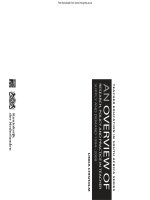Overview of International Tests
Bạn đang xem bản rút gọn của tài liệu. Xem và tải ngay bản đầy đủ của tài liệu tại đây (721.2 KB, 37 trang )
An Overview of
International Tests
iBT TOEFL, IELTS
Helen Huntley
Senior English Language Fellow 2007-08
Ministry of Education and Training,
Hanoi, Vietnam
/>
iBT TOEFL
Why Change the Test?
3 Important Reasons:
Speaking has been added
Focus on the ability to communicate
Measures not only how much the student
knows about English, but how well he or she
can use it
Uses integrated tasks that reflect how
language is actually used
Integration of Skills & Tasks
What are integrated tasks?
Questions that require use of more than one skill at
a time
Read/listen/speak
Listen/speak
Read /listen /write
They give us a better picture of how well the
student can communicate in English.
iBT Test Format
Internet-based test delivered in secure testing
centers on fixed dates
Test time: 4 hours
No computer tutorial – instructions given in each
section
Not computer adaptive
Note-taking allowed
Microphone used for the Speaking section
Typing required for the Writing section
Human raters used for Speaking and Writing
sections
Timing of Sections
Test Section # of Questions Timing
Reading
3-5 passages, 12-14
questions each
60-100 minutes
Listening
4-6 lectures, 6
questions each
2-3 conversations, 5
questions each
60-90 minutes
BREAK
10 minutes
Speaking
6 tasks: 2
independent and 4
integrated
20 minutes
Writing
1 integrated task
1 independent task
20 minutes
30 minutes
Reading Section I
Academic Reading Skills
1. Reading to find information
Scanning for key facts/information
Reading fluency and rate
2. Basic comprehension
Understand main idea, major points and details, vocabulary in
context, pronoun references
Make inferences
3. Reading to learn
Recognize organization and purpose
Understand relationships between ideas
Organize information into a category chart or summary
Infer the connection of ideas in the text
Reading Section II
Length: approx. 700 words each
Categories of academic texts
Exposition
Argumentation
Historical /biographical event/narrative
Question Formats
4 choices – single answer
4 choices – single answer to insert a sentence
‘reading to learn’ Qs with 4+ choices and 1+
answer
Reading: New Features
Reading to Learn questions
sorting/recognizing organization/relationships
category chart
summary
Paraphrase questions
multiple choice of correct paraphrase of a sentence from
text
Glossary
special purpose words and phrases
Listening Section I
Academic Listening Skills (lectures/conversations)
1. Listening for basic comprehension
Comprehend main ideas/important details
2. Listening for pragmatic understanding
Recognize a speaker’s attitude/degree of certainty
Recognize a speaker’s function or purpose
3. Connecting and synthesizing information
Recognize the organization of information
Understand relationships between ideas
Make inferences and draw conclusions
Make connections
Recognize topic changes, examples, digressions, aside
statements, introductions, conclusions
Listening Section II
4-6 lectures, 3-5 minutes long (500-800 words)
2-3 conversations, 3 minutes long, 12-25 exchanges
Pictures on screen to assist listening
Categories of academic listening tasks
Monologue by professor
Interactive lecture
Conversations in an academic setting
Question Formats
4 choices – single answer
4 choices – 1+ answers
Ordering of events or steps in process
Matching objects or text to categories in chart
Listening: New Features
Note taking is allowed
Conversations/lectures longer
Language more natural
One lecture in British/Australian English
New multiple choice question type:
attitude, degree of certainty, purpose
Replaying of portions of listening
Speaking Section I
Academic Speaking Skills
1. In classrooms
Respond to questions
Participate in academic discussions with other students
Synthesize and summarize what they have heard or read
Express their opinions on topics under discussion
2. Outside the classroom
Participate in casual conversations
Express their personal opinions
Communicate in campus situations
Speaking Section II
iBT allows ETS to capture speech and score responses in a
standardized and fair manner.
approx. 20 minutes long
2 independent tasks about familiar topics
Responses based on personal experience
4 integrated tasks
2 Reading/Listening/Speaking tasks
2 Listening/Speaking tasks
Responses based on what was read and heard
Academic and campus-based material
Short listening and reading material
Speaking: Independent Tasks
1. Personal preference
Express and defend a choice from a given category (important
person, events, activities)
Prep time: 15 secs; response time: 45 secs
2. Choice
Make and defend a personal choice between two contrasting
behaviors
Prep time: 15 secs; response time: 45 secs









